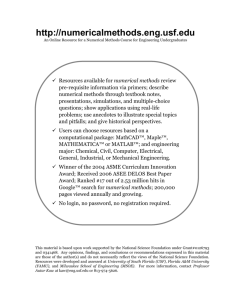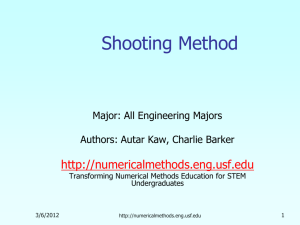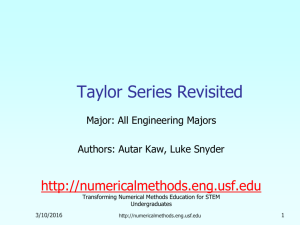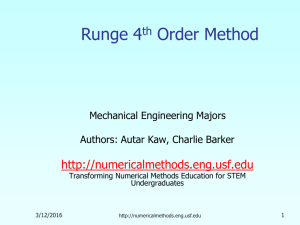Euler Method for Solving Ordinary Differential Equations
advertisement
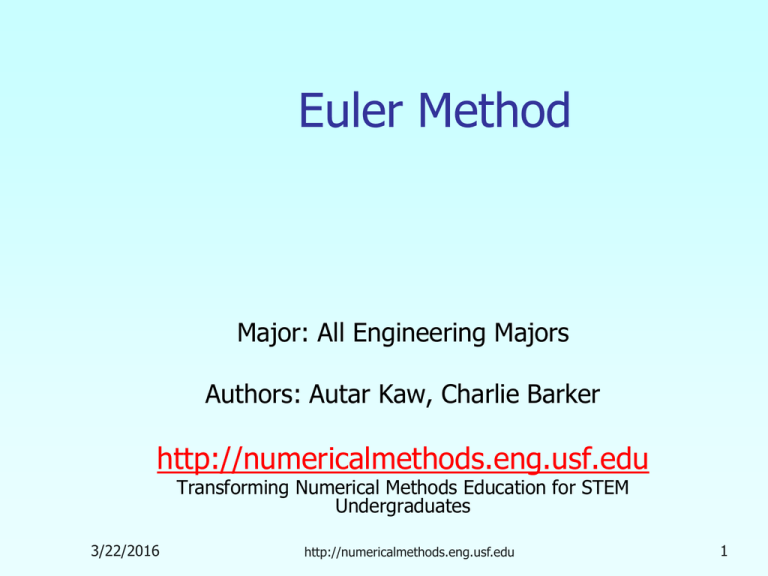
Euler Method Major: All Engineering Majors Authors: Autar Kaw, Charlie Barker http://numericalmethods.eng.usf.edu Transforming Numerical Methods Education for STEM Undergraduates 3/22/2016 http://numericalmethods.eng.usf.edu 1 Euler Method http://numericalmethods.eng.usf.edu Euler’s Method y dy f x, y , y 0 y 0 dx Slope Rise Run y1 y0 x1 x0 f x0 , y 0 y1 y0 f x0 , y0 x1 x0 y0 f x0 , y0 h 3 True value Φ x0,y0 y1, Predicted value Step size, h x Figure 1 Graphical interpretation of the first step of Euler’s method http://numericalmethods.eng.usf.edu Euler’s Method y yi 1 yi f xi , yi h True Value h xi 1 xi yi+1, Predicted value Φ yi h Step size xi xi+1 x Figure 2. General graphical interpretation of Euler’s method 4 http://numericalmethods.eng.usf.edu How to write Ordinary Differential Equation How does one write a first order differential equation in the form of dy f x, y dx Example dy 2 y 1.3e x , y 0 5 dx is rewritten as dy 1.3e x 2 y, y 0 5 dx In this case f x, y 1.3e x 2 y 5 http://numericalmethods.eng.usf.edu Example A ball at 1200K is allowed to cool down in air at an ambient temperature of 300K. Assuming heat is lost only due to radiation, the differential equation for the temperature of the ball is given by d 2.2067 10 12 4 81108 , 0 1200 K dt Find the temperature at t 480 seconds using Euler’s method. Assume a step size of h 240 seconds. 6 http://numericalmethods.eng.usf.edu Solution Step 1: d 2.2067 10 12 4 81 10 8 dt f t , 2.2067 10 12 4 81108 i 1 i f ti , i h 1 0 f t0 , 0 h 1200 f 0,1200 240 1200 2.2067 10 12 1200 4 81108 240 1200 4.5579 240 1 7 106.09 K is the approximate temperature at t t1 t0 h 0 240 240 240 1 106.09K http://numericalmethods.eng.usf.edu Solution Cont Step 2: For i 1, t1 240, 1 106.09 2 1 f t1 ,1 h 106.09 f 240,106.09 240 106.09 2.2067 10 12 106.09 4 81108 240 106.09 0.017595240 110.32 K 2 is the approximate temperature at t t2 t1 h 240 240 480 480 2 110.32K 8 http://numericalmethods.eng.usf.edu Solution Cont The exact solution of the ordinary differential equation is given by the solution of a non-linear equation as 0.92593 ln 300 1.8519 tan 1 0.00333 0.22067 10 3 t 2.9282 300 The solution to this nonlinear equation at t=480 seconds is (480) 647.57 K 9 http://numericalmethods.eng.usf.edu Comparison of Exact and Numerical Solutions Temperature, θ(K) 1400 1200 1000 Exact Solution 800 600 400 h=240 200 0 0 100 200 300 400 500 Time, t(sec) Figure 3. Comparing exact and Euler’s method 10 http://numericalmethods.eng.usf.edu Effect of step size Table 1. Temperature at 480 seconds as a function of step size, h Step, h (480) Et |єt|% 480 240 120 60 30 −987.81 110.32 546.77 614.97 632.77 1635.4 537.26 100.80 32.607 14.806 252.54 82.964 15.566 5.0352 2.2864 (480) 647.57 K 11 (exact) http://numericalmethods.eng.usf.edu Comparison with exact results Temperature, θ(K) 1500 1000 Exact solution 500 h=120 h=240 0 0 -500 100 200 Tim e, t (sec) 300 400 500 h=480 -1000 -1500 Figure 4. Comparison of Euler’s method with exact solution for different step sizes 12 http://numericalmethods.eng.usf.edu Effects of step size on Euler’s Method Temperature,θ(K) 800 400 0 0 100 200 300 400 500 -400 Step size, h (s) -800 -1200 Figure 5. Effect of step size in Euler’s method. 13 http://numericalmethods.eng.usf.edu Errors in Euler’s Method It can be seen that Euler’s method has large errors. This can be illustrated using Taylor series. dy 1 d2y 1 d3y 2 3 xi 1 xi y i 1 y i x x x x ... i 1 i i 1 i 2 3 dx xi , yi 2! dx x , y 3! dx x , y i yi 1 yi f ( xi , yi )xi 1 xi i i i 1 1 2 3 f ' ( xi , yi )xi 1 xi f ' ' ( xi , yi )xi 1 xi ... 2! 3! As you can see the first two terms of the Taylor series yi 1 yi f xi , yi h are the Euler’s method. The true error in the approximation is given by Et 14 f xi , yi 2 f xi , yi 3 h h ... 2! 3! Et h 2 http://numericalmethods.eng.usf.edu Additional Resources For all resources on this topic such as digital audiovisual lectures, primers, textbook chapters, multiple-choice tests, worksheets in MATLAB, MATHEMATICA, MathCad and MAPLE, blogs, related physical problems, please visit http://numericalmethods.eng.usf.edu/topics/euler_meth od.html THE END http://numericalmethods.eng.usf.edu

